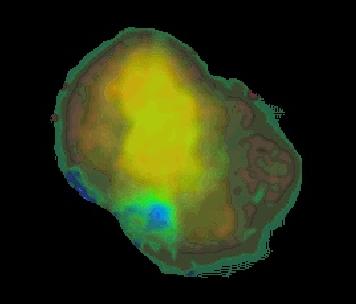Explanation: The life-cycles of stars help drive the ecology of our Galaxy, churning, processing, and redistributing matter. Massive stars reach a spectacular evolutionary endpoint - supernovae explosions which blast off their outer layers, violently merging stellar material with the gas and dust of the Milky Way. The supernova remnant IC 443 is typical of the aftermath. Seen in this false color X-ray image are the shocked, expanding shells of gas from a star which exploded thousands of years ago. Known to be interacting with galactic molecular clouds, the expanding supernova remnant was also recently discovered to have regions of intense higher energy X-ray emission (coded blue in this map) near the molecular cloud boundaries. This X-ray emission may indicate that electrons are being accelerated within the remnant, gaining in energy as they surf back and forth across the expanding shock wave. If so, IC 443 could also be one source of our Galaxy's puzzling high energy cosmic-rays.
1999 2000 2001 2002 2003 2004 2005 2006 2007 2008 2009 2010 2011 2012 2013 2014 2015 2016 2017 2018 2019 2020 2021 2022 2023 2024 2025 |
Январь Февраль Март Апрель Май Июнь Июль Август Сентябрь Октябрь Ноябрь Декабрь |
NASA Web Site Statements, Warnings, and Disclaimers
NASA Official: Jay Norris. Specific rights apply.
A service of: LHEA at NASA / GSFC
& Michigan Tech. U.
|
Публикации с ключевыми словами:
взрывы сверхновых - остаток Сверхновой - ударные волны - рентгеновские лучи - космические лучи - Молекулярные облака
Публикации со словами: взрывы сверхновых - остаток Сверхновой - ударные волны - рентгеновские лучи - космические лучи - Молекулярные облака | |
См. также:
Все публикации на ту же тему >> | |
